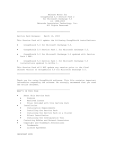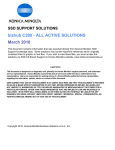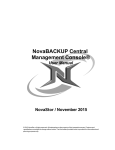Download HP ePrint Enterprise Troubleshooting
Transcript
HP ePrint Enterprise Troubleshooting Guide Release 4.0 © Copyright 2010, 2011-2015 HewlettPackard Development Company, L.P. Microsoft, Windows, Windows Server 2003, Windows Server 2003 R2, Windows Server 2008, Windows Server 2008 R2, Windows Server 2012, and Windows Server 2012 R2 are U.S. registered trademarks of Microsoft Corporation in the United States and/or other countries. BlackBerry®, RIM®, Research In Motion®, SureType® and related trademarks, names and logos are the property of Research In Motion Limited and are registered and/or used in the U.S. and countries around the world. Used under license from Research In Motion Limited. iPhone® and iPad® are registered trademarks of Apple Inc. Android™ is a trademark of Google Inc. Good, Good Technology, Good Dynamics, and Good for Enterprise are trademarks of Good Technology Corporation and its related entities. January 2015 Confidential computer software. Valid license from HP required for possession, use or copying. Consistent with FAR 12.211 and 12.212, Commercial Computer Software, Computer Software Documentation, and Technical Data for Commercial Items are licensed to the U.S. Government under vendor's standard commercial license. The information contained herein is subject to change without notice. The only warranties for HP products and services are set forth in the express warranty statements accompanying such products and services. Nothing herein should be construed as constituting an additional warranty. HP shall not be liable for technical or editorial errors or omissions contained herein. Table of contents 1 Overview ...................................................................................................................................................... 1 2 HP ePrint Enterprise Server ............................................................................................................................ 2 2.1 Installation problems ...................................................................................................................................... 2 2.1.1 Installation error while running SQL script ................................................................................ 2 2.1.2 Error in browsing Domain Users ................................................................................................ 2 2.2 Printing problems ............................................................................................................................................ 4 2.2.1 HP CloudPrint Windows driver was not installed ...................................................................... 4 2.2.2 Unable to print ........................................................................................................................... 4 2.2.2.1 Bidirectional communication ............................................................................... 5 2.2.2.2 Clean up printer spooler files ............................................................................... 5 2.2.2.3 Unable to print (401 error on Submission Test page) ......................................... 5 2.2.3 Microsoft Office files are not printing ........................................................................................ 7 2.2.3.1 Support for Transport Neutral Encapsulation Format (TNEF) emails ............... 10 2.2.3.2 Microsoft Office files do not print when User Account Control is set at its default level .................................................................................................................... 11 2.2.4 Jobs sent to Secure Pull Printers are correctly submitted, but do not print .......................... 12 2.2.5 Jobs sent to Secure Pull Printers do not appear under the correct user ................................ 13 2.2.5.1 Secure Pull Print using HP Access Control ......................................................... 13 2.2.5.2 Secure Pull Print using SafeCom ........................................................................ 15 2.2.6 Jobs sent to PIN printers are correctly submitted, but do not print ....................................... 16 2.2.7 Print-ready documents print continuously ............................................................................. 17 2.2.8 User can print from ePrint Services App but cannot print using Email Printing ..................... 17 2.2.9 Non HP printer status icon reflects the state as “Ready” inspite of printer being readily available ............................................................................................................................................ 17 2.2.10 Missing images in HTML documents ..................................................................................... 18 2.3 Permission problems ..................................................................................................................................... 18 2.3.1 IIS directory permission ........................................................................................................... 18 2.3.2 File permission problems ........................................................................................................ 19 2.3.3 MSMQ queues access rights ..................................................................................................... 20 2.4 API configuration problems .......................................................................................................................... 24 2.4.1 Unable to access the new API .................................................................................................. 24 2.4.1.1 WCF Activation is missing (Windows Server 2008) ............................................ 24 2.4.1.2 SVC mapping is missing (Windows Server 2008 or Windows Server 2012) ...... 25 2.4.1.3 Unable to activate an HP ePrint Enterprise user on iOS or Android devices using the HP ePrint app .................................................................................................. 26 iii 2.4.2 Configuring log for SVC calls .................................................................................................... 27 2.5 Other problems .............................................................................................................................................. 27 2.5.1 Administration page layout problems — bad fonts and/or missing images ......................... 27 2.5.2 No proper host configuration found ........................................................................................ 28 2.5.2.1 Set as Mixed mode .............................................................................................. 28 2.5.2.2 Reset SQL Database connection password ....................................................... 28 2.5.3 SMTP service crashing ............................................................................................................. 29 2.5.4 HP ePrint Enterprise fails to send any emails ......................................................................... 29 2.5.5 Server connection problem using ‘Android’ ............................................................................ 31 2.5.6 HP ePrint Enterprise desktop shortcut does not open after HTTP(s) Port is changed .......... 31 2.5.7 ePrint Enterprise fails to import printers exported in FIS format .......................................... 32 2.5.8 Unable to log in to the HP ePrint Enterprise administration page even after entering credentials ......................................................................................................................................... 33 2.6 Advanced logging .......................................................................................................................................... 33 2.6.1 Driver logging ........................................................................................................................... 33 2.6.2 Persisting Print ready data ...................................................................................................... 34 2.6.3 Save email messages ............................................................................................................... 34 2.6.4 Default logging level ................................................................................................................ 34 3 HP ePrint Enterprise Data Administrator ....................................................................................................... 35 3.1 Error while importing data ............................................................................................................................ 35 4 HP ePrint Enterprise mobile apps .................................................................................................................. 36 4.1 HP ePrint Enterprise app for BlackBerry OS 7.1 and lower .......................................................................... 36 4.1.1 Error while downloading app from ePrint Enterprise Server .................................................. 36 4.1.2 Unable to search printers ........................................................................................................ 36 4.1.3 Can search printers, but not able to print ............................................................................... 36 4.2 HP ePrint Enterprise mobile app for Android ................................................................................................ 36 4.2.1 Server connection problem using ‘Android’ ............................................................................ 36 4.3 HP ePrint Enterprise for Good ....................................................................................................................... 37 4.3.1 Red screen problems ............................................................................................................... 37 4.3.2 Boot loop problems ................................................................................................................. 37 4.3.3 Resetting passcode .................................................................................................................. 37 iv List of figures Figure 2-1 Browse for User Account ..................................................................................................................................... 2 Figure 2-2 Browsing error message ..................................................................................................................................... 2 Figure 2-3 Turn on network discovery ................................................................................................................................. 3 Figure 2-4 HP Cloudprint — Bidirectional communication enabled .................................................................................... 5 Figure 2-5 Internet Information Services (IIS) Manager ...................................................................................................... 6 Figure 2-6 Internet Information Services, printerdirectory ................................................................................................. 6 Figure 2-7 Add/Remove Snap-ins ........................................................................................................................................ 7 Figure 2-8 Required changes: MS Office 2007 ..................................................................................................................... 9 Figure 2-9 Required changes: MS Office 2010 ..................................................................................................................... 9 Figure 2-10 Multi Select Properties ................................................................................................................................... 10 Figure 2-11 User Account Control Settings ........................................................................................................................ 11 Figure 2-12 Registry Editor ................................................................................................................................................ 12 Figure 2-13 Configure Pull Port .......................................................................................................................................... 14 Figure 2-14 Job data properties ......................................................................................................................................... 15 Figure 2-15 Safecom Properties ........................................................................................................................................ 15 Figure 2-16 Use job data logon .......................................................................................................................................... 16 Figure 2-17 Edit a printer ................................................................................................................................................... 18 Figure 2-18 Permissions for inetpub ................................................................................................................................. 19 Figure 2-19 Job submission test ........................................................................................................................................ 19 Figure 2-20 Event Properties ............................................................................................................................................. 20 Figure 2-21 HP CloudPrint Properties ................................................................................................................................ 20 Figure 2-22 Computer Management .................................................................................................................................. 21 Figure 2-23 Local content Properties ................................................................................................................................ 22 Figure 2-24 Advanced Security Settings ............................................................................................................................ 23 Figure 2-25 Advanced Security Settings ............................................................................................................................ 23 Figure 2-26 Select Features ............................................................................................................................................... 24 Figure 2-27 Handler Mappings ........................................................................................................................................... 25 Figure 2-28 Add Managed Handler ..................................................................................................................................... 25 Figure 2-29 Request Restrictions ....................................................................................................................................... 26 Figure 2-30 Select Role Services ........................................................................................................................................ 27 Figure 2-31 New SMTP Receive Connector ........................................................................................................................ 29 Figure 2-32 Remote Network settings ............................................................................................................................... 30 Figure 2-33 CRM Application Properties ............................................................................................................................ 30 Figure 2-34 Externally Secured .......................................................................................................................................... 31 Figure 3-1 Unregistered MS Script Control error during data import ................................................................................ 35 v vi 1 Overview This guide provides information about possible solutions to problems that may occur when using HP ePrint Enterprise server solution and HP ePrint Enterprise (service) application. This guide covers the following categories: ● Server problems ● Application problems 1 2 HP ePrint Enterprise Server 2.1 Installation problems 2.1.1 Installation error while running SQL script For a local SQL installation, make sure the proper credentials are used during configuration of the SQL settings in the installation wizard. The specified account must have administrator privileges. For a remote SQL server, verify connection to Microsoft SQL server 2008, as 2005 is not currently supported. The specified account must have access to create the HP ePrint Enterprise database and create a user account named "cloudprint" with full access to the created database. 2.1.2 Error in browsing Domain Users When browsing for domain users you may receive the following error: Figure 2-1 Browse for User Account Figure 2-2 Browsing error message To resolve this error, complete the following steps: 2 Chapter 2 HP ePrint Enterprise Server 1. Verify the server is added to the domain/workgroup. 2. Start the following Windows services: 3. a. Computer browser b. Function Discovery Resource Publication c. SSDP Discovery d. UPnP Device Host Turn on network discovery as shown here: Figure 2-3 Turn on network discovery 4. Enable NetBIOS over TCP/IP, as shown below. Advanced TCP/IP Settings is accessed using the following navigation: a. Go to Control Panel. b. Select Network Connections. c. Right-click to select the properties of Ethernet. d. Highlight Internet Protocol Version 4 (TCP/IPv4) and select Properties. Section 2.1 Installation problems 3 e. Click Advanced on Internet Protocol Version 4 (TCP/IPv4) properties window . f. On the WINS tab, select the option Enable NetBIOS over TCP/IP. 2.2 Printing problems 2.2.1 HP CloudPrint Windows driver was not installed Verify that your Windows spooler service is enabled and running. When working properly, uninstall and reinstall HP ePrint Enterprise again. It is mandatory to accept the unsigned driver popup during the installation process; otherwise, the printer driver will not be present in the Windows “Printers” folder. 2.2.2 Unable to print Verify you can print from the submission test page on the administration console. If this works, check that there is no error in your device message list while forwarding the email to be printed to the HP ePrint Enterprise email account. If there is an error: ● Check the SMTP domains under the IIS administration page on the HP ePrint Enterprise machine, and verify that the email hostname you set on the policy is listed. If not, it can be added to the domains list as an alias. Add as many aliases as needed. ● Check your company email server settings (i.e. Microsoft Exchange), and allow email forwarding to your HP ePrint Enterprise email account (eprint@eprint_hostname). This is not usually needed, as it is forwarding the email to a hostname on the Intranet. If you cannot print from the submission test page, and this is not an HP device, you may have to manually set the printer personality to PCL5, PCL3, and PS, depending on what your printer supports. If this is an HP device, check your connection to the printer’s IP on TCP port 9100 from the HP ePrint Enterprise machine. Use the telnet to the printer’s IP to port 9100, and check for connection. The only way HP ePrint Enterprise can submit the job to network printers is through this port. 4 Chapter 2 HP ePrint Enterprise Server 2.2.2.1 Bidirectional communication Ensure that bidirectional communication support is enabled for the HP Cloudprint printer: Figure 2-4 HP Cloudprint — Bidirectional communication enabled 2.2.2.2 Clean up printer spooler files If HP CloudPrint printer driver fails to send a job to a printer, the printer spooler can be stuck trying to process an older job, compromising new print jobs. To clean up the printer spooler, follow these steps: 1. Stop Printer Spooler service. 2. Clean up the files from %SYSTEMDIR%\System32\spool\PRINTERS 3. Restart the Printer Spooler service. 2.2.2.3 Unable to print (401 error on Submission Test page) If the following error displays while submitting a job: "A problem occurred while submitting job: The remote server returned an error: (401) Unauthorized" Verify that Internet Information Services are correctly configured on /cloudprintadmin and its subfolders: ● Anonymous Authentication — Enabled ● Windows Authentication — Disabled Section 2.2 Printing problems 5 Figure 2-5 Internet Information Services (IIS) Manager Confirm that settings have been successfully applied to /cloudprintadmin/printerdirectory: Figure 2-6 Internet Information Services, printerdirectory 6 Chapter 2 HP ePrint Enterprise Server 2.2.3 Microsoft Office files are not printing Verify your Microsoft Office applications were properly activated. Try to open each application at least once and see if any popup appears. If it does, mark the checkbox so it will no longer appear. Also, make sure that the user running the Office applications for the first time is the same user specified as Administrator in the installation wizard. Verify that Microsoft Office PIA (Primary Interop Assemblies) is installed correctly in Windows Add/Remove programs. Another common cause of problems is not having a complete installation of Office, or with some automation components missing. For this reason, we recommend a full installation, even if there is some overhead. The above problems may also occur if DCOM components identity of MS Office is not set to Interactive User in 64 bit systems. To set Microsoft Office DCOM objects identity to Interactive User, complete the following steps: 1. Add Component Services snap-in in Microsoft Management Console. a. In command prompt; enter mmc –32 b. Navigate to File > Add/Remove Snap-ins, select Component Services from ‘Available snap-ins list’ and click Add to ‘Selected snap-ins’ list. Figure 2-7 Add/Remove Snap-ins 2. Set up DCOM Configuration a. Run DCOMCNFG, right-click My Computer, and select Properties. b. Choose COM Securities tab. Section 2.2 Printing problems 7 3. 4. 8 c. In Access Permissions, click Edit Defaults, add Network Service, and Allow local access permission. Do the same for <Machine_name>\Users. d. In launch and Activation Permissions, click Edit Defaults, and add Network Service to it, and grant Local launch and Local Activation permissions. Do the same for <Machine_name>\Users. Save the Console with a suitable name a. Apply the Changes and close the component window. b. The Save Console Screen will display. c. Save the Console with a suitable name. Change User Identity of Microsoft Office application to Interactive User a. Open Component Services window (by typing comexp.msc at the Run prompt) b. Open Console Root > Component Services > Computers > My Computer > DCOM Config. Chapter 2 HP ePrint Enterprise Server c. Select Microsoft Office applications of interest (Microsoft Excel Application, Microsoft Office PowerPoint Slide, and Microsoft Office Word 97 – 2003 Document) Figure 2-8 Required changes: MS Office 2007 Figure 2-9 Required changes: MS Office 2010 d. Open Properties, and select Identity tab. Section 2.2 Printing problems 9 e. Select The interactive user as user account for running the application. Figure 2-10 Multi Select Properties f. 5. Click OK. Create temporary storage folder for use by Microsoft Office applications a. Browse to C:\Windows\System32\config\systemprofile in Windows Explorer. b. Create a new folder named Desktop. c. Log out, restart computer, and log back in. If the location selected in ePrint Enterprise host server regional settings does not match the installed language of Microsoft Office, MS Excel attempts to locate the correct MUI Pack. If not found, errors may generate in HP ePrint Enterprise log file. Prevent these errors by installing the appropriate MUI pack for Microsoft Office. 2.2.3.1 Support for Transport Neutral Encapsulation Format (TNEF) emails Transport Neutral Encapsulation Format (TNEF) is a format used by Microsoft Outlook email clients and Microsoft Exchange Servers to send emails. HP ePrint Enterprise does not support TNEF emails. As a result of this, sometimes when printing or forwarding a TNEF-based email message, only the attachments are printed. HP recommends avoiding TNEF within your infrastructure, and sending messages using a more standard MIME format, which is better supported by the SMTP sink component. As a workaround, you can configure Microsoft Outlook or Microsoft Exchange to avoid TNEF encapsulation. Information about controlling TNEF for email clients can be found here: http://support.microsoft.com/kb/290809 Information about controlling TNEF for Exchange Server 2010 can be found here: 10 Chapter 2 HP ePrint Enterprise Server http://technet.microsoft.com/en-us/library/bb310786(v=exchg.141).aspx Information about controlling TNEF for Exchange Server 2013 can be found here: http://technet.microsoft.com/en-us/library/bb310786(v=exchg.150).aspx 2.2.3.2 Microsoft Office files do not print when User Account Control is set at its default level If the User Account Control (UAC) on the Server is set at the default level (UAC is enabled by default), Microsoft Office files might not print. To print Microsoft Office files, disable UAC by completing the following steps: 1. Click Settings, and then click Control Panel. 2. Click User Accounts. 3. Change the User Account Control Setting to Never notify. Figure 2-11 User Account Control Settings 4. Click OK. On Windows 2012 Server, UAC is still active after you selected Never notify. To disable UAC, complete the following steps: 1. Click Start, Run, and type regedit. Click OK. Section 2.2 Printing problems 11 2. In the HKEY_LOCAL_MACHINE\SOFTWARE\Microsoft\Windows\CurrentVersion\policies\system, change the DWORD EnableLUA from 1 to 0. Figure 2-12 Registry Editor 3. Restart your computer. 2.2.4 Jobs sent to Secure Pull Printers are correctly submitted, but do not print A job sent from client to a secure printer (HPAC, SafeCom, Pharos, Nuance Equitrac, or Ringdale FollowMe), correctly rendered (HP ePrint Enterprise server responds positively, and is able to send job to remote Windows queue), but user is unable to retrieve it at the printer. This usually happens because the jobs are not sent directly to a printer, but to a Windows share, which then tries to authenticate users that must pull the job at the printer, given his/her credentials. For this to happen, the job must be sent with proper user identification in form of PJL (Print Job Language) attributes, which are embedded in the job. These attribute headers should look more or less like this: @PJL @PJL @PJL @PJL SET ePrintEmail = "[email protected]" SET ePrintNTAccount = "DOMAIN\john.doe" SET ePrintUsername = "john.doe" ENTER LANGUAGE=PCL When users are auto-provisioned in the database (see auto-provisioning settings), every valid email address that arrives at the server is considered a valid new user, which is then automatically inserted in the database. The HP ePrint Enterprise service account then tries to query the Active Directory with this email address, looking for that user domain\login information. Whenever this fails (i.e., the HP ePrint Enterprise service account specified during setup is not authorized to query the Active Directory), the user is provisioned in the database WITHOUT domain\login information. 12 Chapter 2 HP ePrint Enterprise Server To verify this condition, simply enter the administration console and look for the user that experiencing the problem. Check whether or not the “NT User Account” field is provided: If “NT User Account” is empty, then the PJL header is probably generating like this: @PJL SET ePrintEmail = "[email protected]" @PJL SET ePrintNTAccount = "" @PJL SET ePrintUsername = "" In this case the Windows queue receives the job correctly, but the secure pull printing solution cannot identify the originating user, and therefore can’t retrieve it. Complete the following steps to correct this: 1. Manually enter a valid NT user account. 2. Identify why the service account cannot query Active Directory. The two most common reasons are: a. The HP ePrint Enterprise service account provided during setup is actually a local machine administrator account (not a domain account). To address this, use a domain account with administrator rights instead. b. The provided HP ePrint Enterprise service account, even if a domain account, does not have enough, or specific, rights to query Active Directory. You will have to enable this to allow the HP ePrint Enterprise service to automatically find the user login. 2.2.5 Jobs sent to Secure Pull Printers do not appear under the correct user 2.2.5.1 Secure Pull Print using HP Access Control HPAC SPP job data properties define the buffer size where HPAC SPP will look for the ePrint-specific job header (for example, ePrintUserName). By default, the maximum search length for HPAC SPP is set to 255. This needs to be modified to 4000. To modify the maximum search length, complete the following steps: 1. Right-click the HPAC SPP Queue and select Printer Properties. Section 2.2 Printing problems 13 2. On the Ports tab, select the configured HPAC SPP port and click Configure Port. 3. Select Use job data logon and click Configure. Figure 2-13 Configure Pull Port 14 Chapter 2 HP ePrint Enterprise Server 4. ForJob data string, enter ePrintUsername. For Max search length, enter 4000. Click OK. Figure 2-14 Job data properties 2.2.5.2 Secure Pull Print using SafeCom SafeCom SPP job data properties define the buffer size where SafeCom SPP will look for the ePrint-specific job header (for example, ePrintEmail). The maximum search length for SafeCom SPP needs to be modified to 9999. To modify the maximum search length, complete the following steps: 1. Right-click the SafeCom SPP Queue 2. On the Ports tab, select the configured SafeCom SPP port and click Configure Port. and select Printer Properties. Figure 2-15 Safecom Properties Section 2.2 Printing problems 15 3. Under User authentication select Use job data logon and then click Configure. Figure 2-16 Use job data logon 4. In the Job data string field, enter ePrintEmail. In the Max search length field, enter 9999. Click OK. 2.2.6 Jobs sent to PIN printers are correctly submitted, but do not print In this scenario print jobs are sent from mobile clients to Job Retention-enabled printers and are correctly rendered, but users can’t retrieve them at the printer. To troubleshoot, ensure that the printer configured with Job Retention mode in the ePrint Enterprise server application actually supports Job Storage. In addition, ensure the printer has enough storage on its hard drive to store the job. If the hard drive is full and can’t store a job, the printer generates a hard copy that is sent to the paper output tray of the printer, and the printer hard drive must be cleared. 16 Chapter 2 HP ePrint Enterprise Server 2.2.7 Print-ready documents print continuously This scenario may occur if a print job is submitted to a printer that does not support print-ready functionality for the particular file type. Ensure that only those file types which are supported by the printer are checked. 2.2.8 User can print from ePrint Services App but cannot print using Email Printing For this scenario, check if the user or the user group to which the user belongs has permissions for email printing. Select and edit the printer of interest and check if the user is allowed to do email printing. NOTE: User permissions take precedence over user group permissions. 2.2.9 Non HP printer status icon reflects the state as “Ready” inspite of printer being readily available In this scenario, when sending jobs to non HP printers disable Override printer information with real time data by completing the following steps: Section 2.2 Printing problems 17 1. Click View and Manage Printers screen to redirect to the printer editing form. 2. Select the printer and click Edit. 3. Uncheck the option Override printer information with real data from monitoring. Figure 2-17 Edit a printer 2.2.10 Missing images in HTML documents HTML documents or emails sent in text/html format may contain images whose source refers to internet URLs. While ePrint Enterprise attempts to fetch the proxy details configured in the system, it may not succeed in certain scenarios. If this occurs, manually configure the proxy details in CloudPrint.Settings.xml. 2.3 Permission problems The Microsoft Windows operating system manages a range of system resources used by HP ePrint Enterprise which include files, MSMQ objects, and others. For proper HP ePrint Enterprise operation these resources must have the correct permissions. 2.3.1 IIS directory permission If IIS is already installed, installing HP ePrint Enterprise will deploy ePE related web services under the IIS root folder. For example, E:\inetpub or C:\inetpub folder. The HP ePrint Enterprise installation will fail if the IIS root folder does not have “write” permissions during installation. For successful installation, the administrator needs to provide “write” access to the IIS folder. 18 Chapter 2 HP ePrint Enterprise Server Figure 2-18 Permissions for inetpub 2.3.2 File permission problems Other product installations or user actions may change permissions, denying access to files. The following figures show some failure messages related to wrong permissions on %ALLUSERSPROFILE%\Application Data\Hewlett-Packard\HP CloudPrint folder. Figure 2-19 Job submission test Section 2.3 Permission problems 19 Figure 2-20 Event Properties It is important to set and keep the default permissions. Minimum permissions include Full Control for the Administrators Group and NETWORK SERVICE user. The NETWORK SERVICE access right is necessary for the administration console (including Submission Test page) to work properly. Figure 2-21 HP CloudPrint Properties 2.3.3 MSMQ queues access rights HP ePrint Enterprise uses MSMQ queues to send job processing information throughout HP ePrint Enterprise modules. Default permissions are set on queue creation, which include full control to the owner of the queue (in most cases the SYSTEM account) and full control for Everyone user. 20 Chapter 2 HP ePrint Enterprise Server To verify queue permissions, complete the following steps: 1. Go to Start, Administrative Tools, Computer Management. 2. On the left menu (tree), expand Services and Applications. 3. Expand Message Queuing. 4. Expand Private Queues. Figure 2-22 Computer Management Queue names are defined by LocalControlQueueName, LocalContentQueueName, and PrinterQueuePrefix on CPQueues session of HP ePrint Enterprise settings file. Section 2.3 Permission problems 21 5. Right-click the queue you want to verify, and select Properties. Figure 2-23 Local content Properties Only the owner of the queue can adjust queue permissions. To set the owner, complete the following steps: 22 1. Go to Start, Administrative Tools, Computer Management. 2. On the left menu (tree) expand Services and Applications. 3. Expand Message Queuing. 4. Expand Private Queues. 5. Right-click the queue you want to verify, and select Properties. 6. On queue Properties window, select Security tab. 7. Click Advanced. Chapter 2 HP ePrint Enterprise Server 8. On Advanced Security Settings window, select Owner. Figure 2-24 Advanced Security Settings 9. Click a name on the list (preferably one that reflects the current logged on user or group), and click Apply. Certify that the Current owner is the user/group that has been selected. Figure 2-25 Advanced Security Settings 10. You can now adjust other queue settings. WARNING! Setting the wrong permissions can permanently compromise access to this object, and may require MSMQ reinstallation to restore access. If queue access issues continue: take queue ownership, right-click the queue and select Delete. Restart HP ePrint Enterprise. HP ePrint Enterprise creates the queue with default access permissions. Section 2.3 Permission problems 23 IMPORTANT: Never adjust permissions or change ownership of an MSMQ queue while HP ePrint Enterprise is running. Always shut down the services before performing any changes on MSMQ objects. 2.4 API configuration problems 2.4.1 Unable to access the new API The new API is installed by default under a web application named gd inside the IIS root (e.g. C:\Inetpub \wwwroot) folder. To test minimal functionality, point a web browser to the following URL: ● http://<installation host>/gd/version/ IMPORTANT: Do not forget to append the slash at the end of the URL. A version number in x.x.x format should be returned. However, several errors can occur, and the following sections show some of them. 2.4.1.1 WCF Activation is missing (Windows Server 2008) HP ePrint Enterprise returns 404 errors while accessing http://<installation host>/gd/. This may occur if WCF Activation was installed on the server. To install WCF Activation, go to Server Manager, select Features, and on the right menu, select Add Features. Under .NET Framework 3.0 Features, certify that WCF Activation is selected: Figure 2-26 Select Features Click Next and Install to perform the installation of WCF Activation Service. 24 Chapter 2 HP ePrint Enterprise Server 2.4.1.2 SVC mapping is missing (Windows Server 2008 or Windows Server 2012) The HP ePrint Enterprise installer tries to add the *.svc mapping into the /gd application. In the Handler Mappings section, verify that *.svc is registered: Figure 2-27 Handler Mappings If not registered, you can create a *.svc handler by selecting Add Managed Handled under Actions panel: ● Request path? *.svc ● Enter: System.ServiceModel.Activation.HttpHandler, System.ServiceModel, Version=3.0.0.0, Culture=neutral, PublicKeyToken=b77a5c561934e089. ● Name: svc-Integrated. ● Request Restrictions: Default values can be applied. Figure 2-28 Add Managed Handler Section 2.4 API configuration problems 25 Figure 2-29 Request Restrictions If this doesn’t help, re-map from the parent by setting the Entry Type to Inherited from Local. Right-click the managed handlers svc-Integrated, svc-ISAPI-2.0 and svc-ISAPI-2.0-64 and click Revert to Parent. 2.4.1.3 Unable to activate an HP ePrint Enterprise user on iOS or Android devices using the HP ePrint app If user activation is attempted using the HP ePrint Enterprise app on Apple (iOS) or Android devices, you may get the following error: On the HP ePrint Enterprise client: Activation failed, please verify if you entered the correct code or try to sending the email again. On HP ePrint Enterprise server (Windows Server 2008): HTTP/1.1 405 Method Not Allowed The page you are looking for cannot be displayed because an invalid method (HTTP verb) is being used. To resolve this issue, complete the following steps: 26 Chapter 2 HP ePrint Enterprise Server 1. Check whether you can access http://<installation host>/gd/ on the iOS or Android device. 2. If yes, run any one of the available Web debugging tools such as Wireshark or Fiddler. If the trace result generates the error “HTTP/1.1 405 Method Not Allowed”, go to the next step. 3. Clear the WebDAV Publishing role service from the HP ePrint Enterprise server, and then activate HP ePrint Enterprise again. Figure 2-30 Select Role Services 2.4.2 Configuring log for SVC calls SVC calls logging can be activated by un-commenting out the logging section in IIS root\gd\web.config. The SVC log file is configured to be generated under C:\logs\eprintrest.svclog. To view the log file, use Microsoft Service Trace Viewer. This tool is available in Windows SDK. 2.5 Other problems 2.5.1 Administration page layout problems — bad fonts and/or missing images This error occurs when images and CSS files are not applied to web pages because the Static Content IIS component is missing from server installation. To add, complete the following steps: 1. Go to Start, Administrative Tools, Server Manager. 2. On the left menu (tree), expand Roles. 3. Select Web Server (IIS). Section 2.5 Other problems 27 4. On the right, scroll down to Role Services. The Static Content is not installed by default. 5. Click Add Role Services, and select Static Content. Click Next. 6. Finish the wizard. The IIS must be restarted for changes to take effect. 2.5.2 No proper host configuration found This error occurs when trying to access the administration console on the web browser and the database connection fails. The logging screen does not display, and the following error message appears: The server cannot identify whether it is a primary or a secondary instance. This is usually due to a connection failure with the database from a ‘cloudprint’ provisioned user who should have admin rights. This will prevent the system from working properly. 2.5.2.1 Set as Mixed mode If the SQL Server Express on the local system not installed with login mode set to Mixed. If this is not true, your SQL Server Express might be demanding the administrator to be a Windows user account. If uncertain, locate the following registry key: HKEY_LOCAL_MACHINE\SOFTWARE\Microsoft\Microsoft SQL Server\<instance_name> \MSSQLServer Key: LoginMode Being <instance_name> the current SQL Server Express version, usually MSSQL10.SQLEXPRESS If the LoginMode key is NOT set to 2 (Mixed mode), you can manually do so by editing this registry key, and restart SQL Server Express on the system. This allows for both Windows accounts and provisioned SQL users (such as ‘cloudprint’) to properly connect to the database. This error can also occur if there are two (or more) instances configured as HP ePrint Enterprise primary instances. There can be only one primary instance at a time. 2.5.2.2 Reset SQL Database connection password Depending on SQL Server Login password expiration policy, CloudPrint.Settings.xml may refer to SQL connection string password that is expired. To reset the SQL connection string password in CloudPrint.Settins.xml, complete the following steps: 1. Open Windows Command Prompt 2. Point to ePrint Enterprise installation directory 3. Run SQLConnectionTool/testconnection 4. If the response of step 3, above, communicates a failure to connect to ePrint Enterprise database a. SQLConnectionTool/resetpassword [newpassword] 5. 28 Run SQLConnectionTool/testconnection again to reconfirm successful connection. Chapter 2 HP ePrint Enterprise Server 2.5.3 SMTP service crashing The HP ePrint Enterprise SMTP sink component receives email messages that will be printed. It runs as a plug-in to the SMTP service. If the SMTP sink component fails to process the message (runtime errors), it may start a loop to process the message again, leading to exhaustive system resource usage. If this occurs, complete the following steps: 1. Stop the SMTP service. 2. Go to the folder where messages are located (usually C:\inetpub\mailroot\Queue). 3. Remove all .eml files from folder, and send it to the HP ePrint Enterprise support team to be investigated. Restart the SMTP service. 2.5.4 HP ePrint Enterprise fails to send any emails This problem can occur when there is an authentication issue between the ePrint server and the Exchange server when using Exchange Server 2007. First, start with a new custom receive connector. (Think of receive connectors as protocol listeners. The closest equivalent to Exchange 2003 is an SMTP Virtual Server. A new one must be created, as you will want to scope the remote IP Address(es) that you will allow.) Figure 2-31 New SMTP Receive Connector Pay particular attention to the Remote Network settings screen. This is where you will specify the IP ranges of servers that will be allowed to submit mail. Add the IP’s of all the ePrint Servers (Primary as well as Secondary instances). Section 2.5 Other problems 29 Figure 2-32 Remote Network settings Next you will need to create the connector and open the Properties. Make your new scoped connector an externally Secured connector Before performing this step, the Exchange Server permission group must be enabled. From Properties, go to the Permissions Groups tab and select Exchange servers. Figure 2-33 CRM Application Properties Continue to the Authentication tab, and select Externally Secured (for example, with IPsec). 30 Chapter 2 HP ePrint Enterprise Server This means you have complete confidence that the previously designated IP addresses are trusted by your organization. Figure 2-34 Externally Secured WARNING! If you do not perform these two steps in order, the GUI blocks you from continuing. Do not use this setting lightly. You will be granting multiple rights, including the ability to send on behalf of users in your organization, the ability to ResolveP2 (that is, make it so that the messages appear to be sent from within the organization rather than anonymously), bypass anti-spam, and bypass size limits. Basically, you are telling Microsoft Exchange to ignore internal security checks because you trust these servers. The nice thing about this option is that it is simple and grants the common rights that most people probably want. 2.5.5 Server connection problem using ‘Android’ This message can sometimes appear when trying to enable Enterprise printing on Android mobile devices. To resolve this error, from within the Android ePrint app, navigate to Settings, and then turn on ePrint. When prompted for the ePrint Enterprise server information, enter http://FQDN/gd (where “FQDN” = the actual fully qualified domain name for the ePrint Enterprise server). 2.5.6 HP ePrint Enterprise desktop shortcut does not open after HTTP(s) Port is changed This can happen when the HTTP(s) port is changed from its default value, i.e.:80, and 443. To fix this, complete the following steps: 1. Go to the folder where ePrint is located (usually C:\Program Files\Hewlett-Packard\HP ePrint Enterprise). 2. Right-click the internet short HP CloudPrint Enterprise, and open Properties. 3. Change the URL from http://localhost/CloudPrintAdmin/ to http(s)://localhost:<port>/ CloudPrintAdmin/ Section 2.5 Other problems 31 4. Click OK. 2.5.7 ePrint Enterprise fails to import printers exported in FIS format When you try to import printers from an FIS sheet, it fails to import the printers with the following error: Failed to create importer Component. This can happen if the importer component is not registered in your system. Execute the following statement in your command prompt, and try again to import the printers: C:\WINDOWS\Microsoft.NET\Framework\v2.0.50727\RegSvcs.exe "C:\Program Files\Hewlett-Packard\HP ePrint Enterprise \com.hp.cloudprint.mixedarchcomponents.dll" 32 Chapter 2 HP ePrint Enterprise Server NOTE: Microsoft 2007 Office System Driver: Data Connectivity Components should also be installed on the Server if you are using any version of Microsoft Office, other than Microsoft Office 2007. It can be downloaded from here: http://www.microsoft.com/en-us/download/details.aspx?id=23734 2.5.8 Unable to log in to the HP ePrint Enterprise administration page even after entering credentials You are not be able to log in to the HP ePrint Enterprise administration page, even after entering credentials. After entering user name and password credentials, and clicking Login, the login page remains unchanged with a blank password field. To resolve this issue, complete the following steps: 1. Close the HP ePrint Enterprise administration page. 2. In the Server Manager, click Configure IE ESC. 3. In the IE ESC window, turn off this feature for the Administrators group. 4. Launch the HP ePrint Enterprise and log in with your credentials. 2.6 Advanced logging HP ePrint Enterprise can be configured to log more information to help the support team while investigating and resolving issues. 2.6.1 Driver logging To configure verbose logging to HP CloudPrint printer driver, add a REG_SZ key named DriverLogLevel with value ‘DEBUG’ inside HKEY_LOCAL_MACHINE\SOFTWARE\Hewlett-Packard\HP CloudPrint registry key: Section 2.6 Advanced logging 33 2.6.2 Persisting Print ready data Logging of print ready data can be enabled or disabled by creating a key named SavePrintReadyData (REG_SZ, string) with value 1= log enabled, 0 = log disabled under HKEY_LOCAL_MACHINE\SOFTWARE \Hewlett-Packard\HP CloudPrint registry path. Log is stored under hpCloudPrint/logs folder. 2.6.3 Save email messages For debugging purposes, the SMTP sink component can save email messages in raw format. When this option is active, text files containing the email will be written to the store folder (default %ALLUSERSPROFILE% \Application Data\Hewlett-Packard\HP CloudPrint\store). To configure it, add a REG_DWORD key named SaveRawMessage with value 1 inside HKEY_LOCAL_MACHINE \SOFTWARE\Hewlett-Packard\HP CloudPrint registry key: 2.6.4 Default logging level HP ePrint Enterprise logging is configured to log error messages only. For more verbose logging, configure the %ALLUSERSPROFILE%\Application Data\Hewlett-Packard\HP CloudPrint\conf\log4net.xml file replacing the default level value from “ERROR” to “ALL” inside the root element. 34 Chapter 2 HP ePrint Enterprise Server 3 HP ePrint Enterprise Data Administrator 3.1 Error while importing data The Importer/Exporter tool relies on Microsoft Script Control (MSSCRIPT.OCX) for its data importing processes. Some operating systems (in particular, Windows 2008) may not have this component registered by default. In this is the case, the following error may display when importing data: Figure 3-1 Unregistered MS Script Control error during data import One possible workaround is to register Microsoft Script Control. For 64-bit Windows Server 2008, open a command prompt and issue the following command: > regsvr32.exe %SystemRoot%\SysWOW64\msscript.ocx IMPORTANT: The command prompt needs to be “run as administrator” otherwise the access to the registry may fail. Section 3.1 Error while importing data 35 4 HP ePrint Enterprise mobile apps 4.1 HP ePrint Enterprise app for BlackBerry OS 7.1 and lower 4.1.1 Error while downloading app from ePrint Enterprise Server If “Error 907 Invalid COD file” occurs while downloading the BlackBerry mobile client from http://<installation host>/cp, verify the IIS mime types in the IIS admin page, make sure the file types for .cod and .jad are properly set, having only one entry each: ● .jad = text/vnd.sun.j2me.app-descriptor ● .cod = application/vnd.rim.cod 4.1.2 Unable to search printers Check if your HP ePrint Enterprise server is running with all components displaying a green light. This can be verified on the HP ePrint Enterprise administration page: ● http://<installation host>:<port>/CloudPrintAdmin If the server is ok, verify the IT policies for the HP ePrint Enterprise server email address and hostname are correct, and are properly set. The policies on the BES server should be set as custom IT policies. After setting them, it may take some time before the devices are updated. For test purposes, you can push the configuration from the CloudPrintAdmin website. This is not for production, since the mobile devices will overwrite this configuration with the one from the BES during BlackBerry reboots. Make sure that your BlackBerry can access the HP ePrint Enterprise web server. This requires the BES MDS tunnel, and no firewall blocking TCP port 80. To test your access to the HP ePrint Enterprise server, try to open http://<installation host>/cp from the BB Browser. If this fails, printing will not occur. 4.1.3 Can search printers, but not able to print This error can occur if the BES server is able to reach the primary instance (where search is performed), but cannot reach the secondary instance where printing occurs. Confirm that BES server can communicate with HP ePrint Enterprise primary and secondary instance, and that DNS and network aliases (if any) are properly configured. 4.2 HP ePrint Enterprise mobile app for Android 4.2.1 Server connection problem using ‘Android’ This message can sometimes appear when trying to enable Enterprise printing on Android mobile devices. To resolve this error, from within the Android ePrint app, navigate to Settings, and then turn on ePrint. When prompted for the ePrint Enterprise server information, enter http://FQDN/gd (where “FQDN” = the actual fully qualified domain name for the ePrint Enterprise server). 36 Chapter 4 HP ePrint Enterprise mobile apps 4.3 HP ePrint Enterprise for Good 4.3.1 Red screen problems Depending on your Good server configuration, you may notice a red screen immediately following the first installation, followed by the first log-in. In this occurs, the workaround is to stop the running application and start it again. The application will then display the agree screen and should work properly from that moment on (with no more freezes or red screen occurrences). This usually occurs if the configuration in Good server prevents the freeze. To find and set the policy, use the Good Control web console: Policy Sets: Security Policies: check the “Require User Passwords”. 4.3.2 Boot loop problems In Android devices running Jelly Bean versions 4.1.1 or 4.1.2, the boot loop problem is often noticed when connecting to certain wireless networks. Attempted connections to certain wireless networks causes a system error in the Android device, which then reboots. As the device boots up, it attempts the same wireless connection, causing the device to reboot again, and resulting in a ‘boot loop’. This happens because there is an optional attribute that is not provided by some routers that the Android system code is expecting. A lot of Android technical forum posts speculate that it has to do with route to the internet, or lack thereof (i.e. Wireless Direct). In some way, this combines with a new wireless settings menu option provided by Android. The setting reads “Avoid poor wireless connections” and is in the form of a checkbox. The prescribed usage/benefit of this setting is to aid customers in avoiding networks with poor signal or bandwidth that could hinder their experience. To resolve this boot loop problem, use one of the following: ● First option is to disable the “Avoid poor wireless connections” checkbox. However, some manufactures do not display this option to the user. So during the reboots you can quickly get into the wireless settings and either disable wireless, remove the current network configuration, or disable “Avoid poor wireless connections” then the reboots should stop. ● Second option is to have the user leave the range of the wireless network, or disable the wireless network, if it is a router to which they have access to. This allows the phone/tablet to fully boot. The user can then disable Avoid poor wireless connections. A network can now be selected from the wireless list (if the network is out of range or disabled, it should be at the bottom), and choose Forget, which removes the profile for that network. The device will not attempt to connect to it. This is not a problem with the routers, but with Google’s implementation of the spec. Disabling the Avoid poor wireless connections setting is the ideal method for dealing with this issue. However, if user cannot access the setting, the remaining options are few: obtain a new router, wait for an OS update, or get a new device. 4.3.3 Resetting passcode You may occasionally see a prompt to enter the password for credential storage, instead of being prompted to set a pin or password. This often means the user has not entered a password, or does not remember the password. Online research indicates this usually occurs for users attempting to set up wifi or VPN. If this occurs, complete the following steps: 1. Cancel out of the Type the password for credential storage window. Section 4.3 HP ePrint Enterprise for Good 37 38 2. Open the settings on your device. 3. Go to Settings > Security, and add a lock screen pin to your device. Chapter 4 HP ePrint Enterprise mobile apps






















































